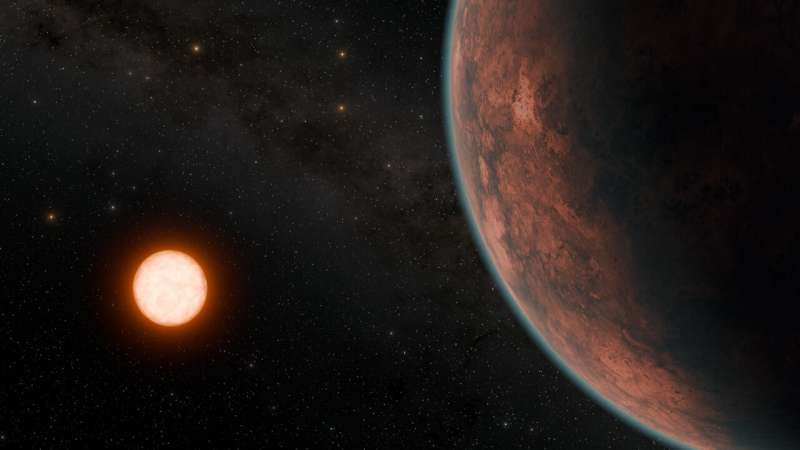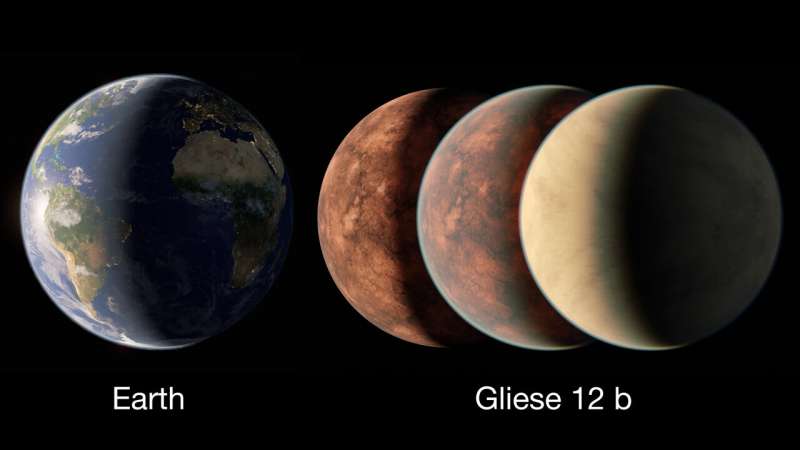This article has been reviewed according to Science X's editorial process and policies. Editors have highlighted the following attributes while ensuring the content's credibility:
fact-checked
peer-reviewed publication
trusted source
proofread
Potentially habitable 'exo-Venus' with Earth-like temperature discovered

Astronomers have made the rare and tantalizing discovery of an Earth-like exoplanet 40 light-years away that may be just a little warmer than our own world. The new paper "Gliese 12 b, A Temperate Earth-sized Planet at 12 Parsecs Discovered with TESS and CHEOPS," has been published in the Monthly Notices of the Royal Astronomical Society.
The potentially habitable planet, named Gliese 12 b, orbits its host star every 12.8 days, is comparable in size to Venus—so slightly smaller than Earth—and has an estimated surface temperature of 42°C (107°F), which is lower than most of the 5,000-odd exoplanets confirmed so far.
That is assuming it has no atmosphere, however, which is the crucial next step to establishing if it is habitable. It may have an Earth-like atmosphere, one more akin to Venus—which experienced a runaway greenhouse effect that made it a 400°C (752°F) hellhole—no atmosphere, or perhaps a different kind of atmosphere not found in our solar system.
Getting an answer is vital because it would reveal if Gliese 12 b can maintain temperatures suitable for liquid water—and possibly life—to exist on its surface, while also unlocking answers about how and why Earth and Venus evolved so differently.
Gliese 12 b is by no means the first Earth-like exoplanet to have been discovered, but as NASA has said, there are only a handful of worlds like it that warrant a closer look.
It has been billed as "the nearest, transiting, temperate, Earth-size world located to date" and a potential target for further investigation by the James Webb Space Telescope.
The closest Earth-like exoplanet to us—and possibly the most famous—is Proxima Centauri b, which is only four light-years away. However, because it is not a transiting world, we still have a lot to learn about it, including whether it has an atmosphere and the potential to harbor life.
Most exoplanets are discovered using the transit method, where a planet passes in front of its star from our point of view, causing a dip in the host star's brightness.
During a transit, the star's light also passes through an exoplanet's atmosphere and some wavelengths get absorbed. Different gas molecules absorb different colors, so the transit provides a set of chemical fingerprints that can be detected by telescopes like Webb.
Gliese 12 b could also be significant because it may help reveal whether the majority of stars in our Milky Way galaxy—i.e. cool stars—are capable of hosting temperate planets that have atmospheres and are therefore habitable.
It orbits a cool red dwarf star called Gliese 12, which is almost 40 light-years away from Earth in the constellation Pisces.
"Gliese 12 b represents one of the best targets to study whether Earth-size planets orbiting cool stars can retain their atmospheres, a crucial step to advance our understanding of habitability on planets across our galaxy," said Shishir Dholakia, a doctoral student at the Center for Astrophysics at the University of Southern Queensland in Australia.
He co-led a research team with Larissa Palethorpe, a doctoral student at the University of Edinburgh and University College London.
The exoplanet's host star is about 27% of the size of our sun and has a surface temperature that is around 60% of our own star.
However, the distance separating Gliese 12 and the new planet is just 7% of the distance between Earth and the sun. Gliese 12 b therefore receives 1.6 times more energy from its star as Earth does from the sun and about 85% of what Venus experiences.

This difference in solar radiation is important because it means the planet's surface temperature is highly dependent on its atmospheric conditions. As a comparison to Gliese 12 b's estimated surface temperature of 42°C (107°F), Earth has an average surface temperature of 15°C (59°F).
"Atmospheres trap heat and—depending on the type—can change the actual surface temperature substantially," Dholakia explained. "We are quoting the planet's 'equilibrium temperature," which is the temperature the planet would be if it had no atmosphere.
"Much of the scientific value of this planet is to understand what kind of atmosphere it could have. Since Gliese 12 b gets in between the amount of light as Earth and Venus get from the sun, it will be valuable for bridging the gap between these two planets in our solar system."
Palethorpe added, "It is thought that Earth's and Venus's first atmospheres were stripped away and then replenished by volcanic outgassing and bombardments from residual material in the solar system.
"The Earth is habitable, but Venus is not due to its complete loss of water. Because Gliese 12 b is between Earth and Venus in temperature, its atmosphere could teach us a lot about the habitability pathways planets take as they develop."
The researchers, along with another team in Tokyo, used observations by NASA's TESS (Transiting Exoplanet Survey Satellite) to help make their discovery.
"We've found the nearest, transiting, temperate, Earth-size world located to date," said Masayuki Kuzuhara, a project assistant professor at the Astrobiology Center in Tokyo, who co-led a research team with Akihiko Fukui, a project assistant professor at the University of Tokyo.
"Although we don't yet know whether it possesses an atmosphere, we've been thinking of it as an exo-Venus, with similar size and energy received from its star as our planetary neighbor in the solar system."
An important factor in retaining an atmosphere is the storminess of its star. Red dwarfs tend to be magnetically active, resulting in frequent, powerful X-ray flares.
However, analyses by both teams conclude that Gliese 12 shows no signs of such extreme behavior, raising hopes that Gliese 12 b's atmosphere may still be intact.
"We know of only a handful of temperate planets similar to Earth that are both close enough to us and meet other criteria needed for this kind of study, called transmission spectroscopy, using current facilities," said Michael McElwain, a research astrophysicist at NASA's Goddard Space Flight Center in Greenbelt, Maryland, and a co-author of the Kuzuhara and Fukui paper.
"To better understand the diversity of atmospheres and evolutionary outcomes for these planets, we need more examples like Gliese 12 b."
At 40 light-years from Earth, Gliese 12 b is about the same distance as the TRAPPIST-1 system.
This is made up of seven planets, all roughly in Earth's size range and likely rocky, orbiting a red dwarf star.
Three of these are in the habitable zone but at least two—and probably all of them—have no atmosphere and are likely barren, dismissing hopes when they were first discovered eight years ago that they could be water worlds hosting life.
More information: Shishir Dholakia et al, Gliese 12 b, A Temperate Earth-sized Planet at 12 Parsecs Discovered with TESS and CHEOPS, Monthly Notices of the Royal Astronomical Society (2024). DOI: 10.1093/mnras/stae1152
Journal information: Monthly Notices of the Royal Astronomical Society
Provided by Royal Astronomical Society



















